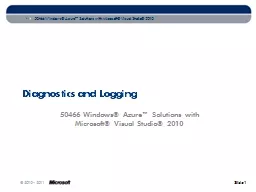PPT-Diagnostics and Logging 50466 Windows® Azure™ Solutions with Microsoft® Visual Studio®
Author : cheryl-pisano | Published Date : 2018-12-06
Debugging and Logging Issue As a NET developer you have probably become very familiar with debugging tools and log files to gain an understanding of how your applications
Presentation Embed Code
Download Presentation
Download Presentation The PPT/PDF document "Diagnostics and Logging 50466 Windows® ..." is the property of its rightful owner. Permission is granted to download and print the materials on this website for personal, non-commercial use only, and to display it on your personal computer provided you do not modify the materials and that you retain all copyright notices contained in the materials. By downloading content from our website, you accept the terms of this agreement.
Diagnostics and Logging 50466 Windows® Azure™ Solutions with Microsoft® Visual Studio®: Transcript
Download Rules Of Document
"Diagnostics and Logging 50466 Windows® Azure™ Solutions with Microsoft® Visual Studio®"The content belongs to its owner. You may download and print it for personal use, without modification, and keep all copyright notices. By downloading, you agree to these terms.
Related Documents














